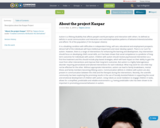
Description about the Kaspar Project
- Subject:
- Applied Science
- Health, Medicine and Nursing
- Material Type:
- Reading
- Date Added:
- 11/04/2019

Description about the Kaspar Project

This course instructs students on how to develop technologies that help people measure and communicate emotion, that respectfully read and that intelligently respond to emotion, and have internal mechanisms inspired by the useful roles emotions play.
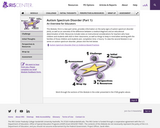
This Module, first in a two-part series, provides information on the early signs of autism spectrum disorder (ASD), as well as an overview of the difference between a medical diagnosis and an educational determination of ASD. Resources include notes on instructional considerations for teachers who have children and students with ASD in their classrooms, as well as things to keep in mind when working with the families of those children and students (est. completion time: 2 hours).
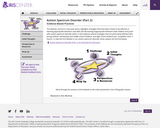
This Module, second in a two-part series, highlights strategies that have been shown to be effective in teaching appropriate behaviors and skills and decreasing inappropriate behaviors with children and youth with autism spectrum disorder (ASD). It next explores several strategies that are particularly effective with young children, elementary and middle school students, and high school students (est. completion time: 3 hours).

This course illuminates current theories about autism together with challenges faced by people on the autism spectrum. Theories in communicating, interacting socially, managing cognitive and affective overload, and achieving independent lifestyles are covered. In parallel, the course presents state-of-the-art technologies being developed for helping improve both theoretical understanding and practical outcomes. Participants are expected to meet and interact with people on the autism spectrum. Weekly reading, discussion, and a term project are required.

Biology is designed for multi-semester biology courses for science majors. It is grounded on an evolutionary basis and includes exciting features that highlight careers in the biological sciences and everyday applications of the concepts at hand. To meet the needs of today’s instructors and students, some content has been strategically condensed while maintaining the overall scope and coverage of traditional texts for this course. Instructors can customize the book, adapting it to the approach that works best in their classroom. Biology also includes an innovative art program that incorporates critical thinking and clicker questions to help students understand—and apply—key concepts.
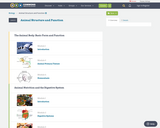

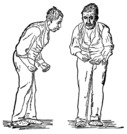
By the end of this section, you will be able to:Describe the symptoms, potential causes, and treatment of several examples of nervous system disorders
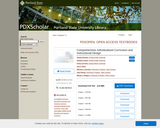
This online textbook addresses the population of individuals with disabilities that experience complex lifelong needs across multiple areas in their lives. Drs. Sennott and Loman drafted this book (along with the help from some friends) with the hope of providing pertinent, practical, and current resources to future special educators who plan to serve individuals with complex disabilities.

This resource is a video abstract of a research paper created by Research Square on behalf of its authors. It provides a synopsis that's easy to understand, and can be used to introduce the topics it covers to students, researchers, and the general public. The video's transcript is also provided in full, with a portion provided below for preview:
"Over the past decade, research has linked autism spectrum disorder to a dysregulation of the relationship between the brain, the gut, and the trillions of microbes that reside in the gut. Alterations in this so-called “microbiota-gut-brain” axis can be detected as changes in small molecules produced by the microbiota in feces and urine. One of these molecules is p-cresol, a byproduct of bacterial fermentation of proteins. Studies have shown that p-cresol is more abundant in people with autism than in neurotypical individuals. To explore p-cresol’s possible role in autism, researchers fed the compound to mice and monitored their behavior. Mice exposed to p-cresol showed autistic-like behaviors that persisted after treatment was discontinued. Compared to control mice, treated mice showed reduced sociability, reduced social contact, and more frequent stereotypies such as head shakes and circlings..."
The rest of the transcript, along with a link to the research itself, is available on the resource itself.
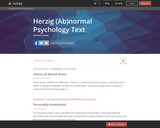
Open textbook on abnormal psychology. Includes sections on personality disorders, mood disorders, anxiety, schizophrenia, psychopathy, behavioral disorders, autism and disassociative disorders.
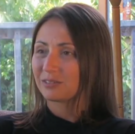
Interviews of Parents of Autistic Children for Families Advocating Autism Now (FAAN) in August 2012 in Eureka, California.http://humboldtfaan.org/Creative Co...
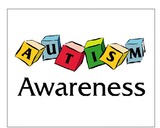
An introductory module to autism spectrum disorders (ASD), and a discussion of inclusivity and diversity. Multiple videos, books and articles are included.
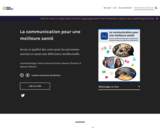
La communication est au cœur des rencontres entre le personnel de la santé et les patients. Cette ressource présente des connaissances et des approches de communication pour mieux servir patients et clients présentant des handicaps intellectuels et développementaux. Elle s’adresse principalement aux étudiants en sciences de la santé mais elle peut aussi intéresser la communauté étudiante en travail social, en psychologie, en éducation et en droit. De plus, plusieurs notions et approches présentées dans ce module sont applicables aux interactions avec des patients ayant des capacités cognitives et communicationnelles atypiques dues à d’autres conditions telles qu’un traumatisme crânien, la démence ou l’aphasie.

This seminar focuses on reading and discussion of current linguistic theory, first language acquisition and language disorders in young children. It also focuses on development of a principled understanding of language disorders at the phonological, morphological and syntactic levels, examining ways in which these disorders confront theories of language and acquisition.
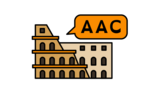
Inspired by the guidelines of the Universal Design for Learning (CAST, 2018), "Universal Latin Fables" wants to give the opportunity to discover Phaedrus' fables to as many students as possible. The web-site uses storytelling process based entirely on the Augmentative and Alternative Communication (AAC). Not only does it make the reading process easier, but it also allows autism spectrum students to understand the fable on several levels.
To whom it turns?
DYSLEXIA:
This website uses the OpenDyslexic font in order to increase readability.
AUTISM SPECTRUM
All the fables can be read using Alternative and Augmentative Communication and PECS symbols offered by SymWriter, specific for autistic people but usable by everyone.
VISUAL IMPAIRMENT
The "Listen" step can be useful to blind students. Furthermore, the website is responsive and the text is scalable.
HEARING IMPAIRMENT
The "Watch" and the "Read" step can be useful to deaf students.
The website is designed to be used by adults and teenagers or by children helped by a parent or a supporting teacher.

This module is designed for pre-service teachers who are learning about low-incidence disabilities. The following are included: Multicultural and Bilingual Aspects of Special EducationLow-Incidence, Multiple, and Severe DisabilitiesAutism Spectrum Disorder (ASD) Learners with Emotional or Behavioral DisordersLearners who are Deaf or Hard of HearingLearners with Blindness or Low VisionLearners with Physical Disabilities and Other Health ImpairmentsGifted
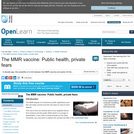
A decade ago, the possibility of a link between the MMR vaccine and autism hit the media. Fear of the vaccine spread rapidly and, despite an almost unanimous consensus that the claim was unfounded, still persists today. In this unit, we'll examine why this controversy took on such a life of its own and why parents still agonise about the vaccine.

This course is an examination of philosophical theories of action and motivation in the light of empirical findings from social psychology, sociology, and neuroscience. Topics include belief, desire, and moral motivation; sympathy and empathy; intentions and other committing states; strength of will and weakness of will; free will; addiction and compulsion; guilt, shame and regret; evil; self-knowledge and self-deception; and, virtues and character traits.
This course is a CI-M course.